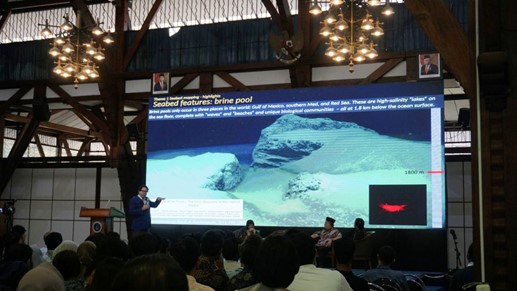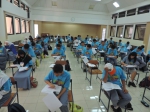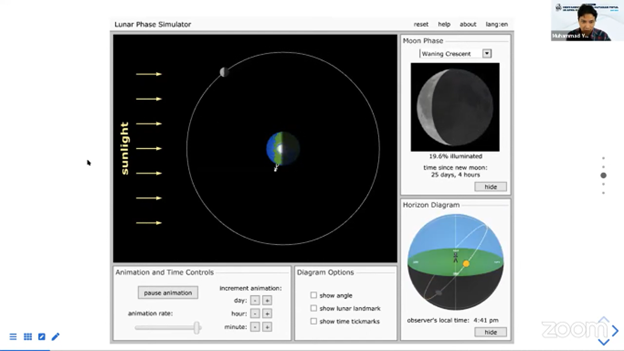Innovation Expedition: ITB Post-Harvest Technology Students Explore the Production and Utilization of VCO
By Anggun Nindita
Editor Anggun Nindita

JATINANGOR, itb.ac.id – Students of Post-Harvest Technology (TPP) at the Bandung Institute of Technology, participating in the elective course on Post-Harvest Handling Systems for Plantation Products, visited one of the virgin coconut oil (VCO) processing sites associated with the Small and Medium Enterprises (UMKM) in Parahyangan Banjar, West Java. This field trip was conducted on Saturday (11/11/2023) as part of the course activities.
At the site, TPP students from the cohorts of 2020 and 2021 learned about coconut processing, starting from husking, and grating, to fermentation and packaging. This facility was initiated by three individuals affectionately referred to as Kang Aan, Kang Yusuf, and Kang Ian, since September 2022. Despite being recently established, this small-scale industry has already created numerous innovations through their self-taught learning experiences.
The initiation of this VCO processing stemmed from the surplus of coconuts produced, which faced unstable market prices. Consequently, local residents expressed a desire to increase the added value of coconuts, leading to the development of VCO processing, known for its various health benefits.
Over time, product diversification was implemented, branching into VCO-based hair products. Sales of the products increased significantly following the launch of this new product line.
"Turns out, health education is more challenging than lifestyle marketing," said Kang Yusuf.
The raw material for this industry is mature coconuts, which have been stripped of their husks and display round, hard-shelled nuts. These raw materials are sourced from trees around the processing area and leftover goods from the market. One characteristic of mature coconuts is the presence of a sprout, which is the coconut seedling, resembling a ball and having a whitish-yellowish color.
"Here, it's called 'butuh' and can be eaten," he said.
According to him, mature coconuts have more flesh, which contains a higher amount of oil. Therefore, this small-scale industry can produce 70-75 milliliters of VCO per coconut.
After being separated from its shell, the coconut flesh is washed with running water. Subsequently, it undergoes grating using a solar-powered grating machine. The grated coconut must then be promptly processed further to obtain good-quality oil.

The grated coconut undergoes a soaking process in a designated area with water, where workers wear aprons, masks, gloves, and specific footwear. Subsequently, coconut milk extraction is carried out using a press. After the extraction, the addition of water is repeated once more. The coconut milk is then left to settle in a container until it separates from the water, with a tap at the bottom of the container.
Then, a 24-hour fermentation process takes place until layers of VCO, blondo, and water are formed. Throughout the fermentation, the container is covered with a cloth layer to maintain its temperature stability. The subsequent step involves centrifugation for 15-20 minutes until the VCO separates on top and the blondo solidifies. The oil is then poured through a funnel and a 5-level filter, resulting in clear VCO ready for packaging.
The packaging is done in 50-milliliter and 100-milliliter bottles. For the hair product, several substances, including fragrances, are added. The bottles for the hair oil are in spray form.
Kang Yusuf explained each stage clearly and in detail, including various experiments they conducted. They crafted various tools used in processing themselves, such as a centrifuge made from an iron framework, a press utilizing a perforated pot, and a simple multi-level filter without any additional pump or power source.
In addition to their own experiments, the VCO processing team also participated in millennial farmer training, received visits from relevant agencies, and even hosted visits from educational institutions like ITB.
We want to prove that in this village, with freely accessible information sources, we are capable of creating simple equipment and advancing this VCO business," he explained
The products obtained have received the Household Industry Food Product Certificate (PIRT). One of the main markets for VCO is the herbal industry around the production areas, specifically in Singaparna and Banjar, West Java. The supply to these industries reaches 30-50 liters every month. Further processing is carried out there to produce items like soap, ointments/lotions, and other similar products.
In the future, it is hoped that cooperation with the herbal industry will grow stronger. There are also other products that are still in the developmental stage, such as pomade.
"There are plans to obtain BPOM certification, and the intention is to sell these herbal products directly here. This (pomade) is not yet for sale; it's still in the trial phase," he continued.
One of the students participating in this agenda, Jilan, revealed that the series of coconut processing observed aligns with the materials learned in class.
"We gained a lot of insights and new experiences," said Jilan.
In addition to the main process flow, they also explained the waste generated from VCO processing. Coconut husking yields coconut water and shells, while the pressing process produces coconut gratings residue. These byproducts are handed over to other industries to be turned into products such as nata de coco, charcoal, and animal feed.
This signifies that the biorefinery process, which involves utilizing one raw material to produce multiple valuable products, has been implemented. The concept of enabling sustainability is one of the crucial aspects studied at the School of Life Sciences and Technology (SITH) at ITB.
Reporter: Ayesha Lativa Mafaza (Post-Harvest Technology, 2021)
Documentation: Academic Assistant of the Post-Harvest Technology Study Program
Translator: Hanifa Juliana (Urban and Regional Planning, 2020)
Editor: Anggi Nurdiani (Management, 2024)

.jpg)

.jpg)
.jpg)
.jpg)


